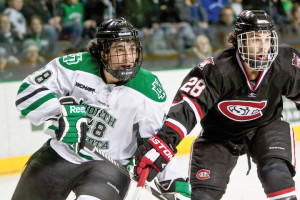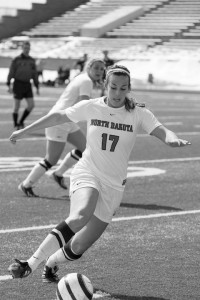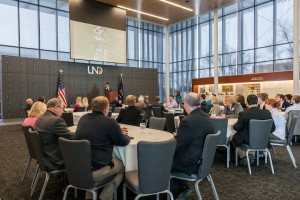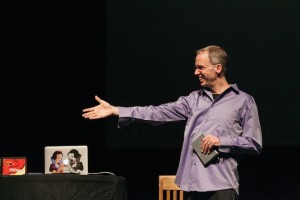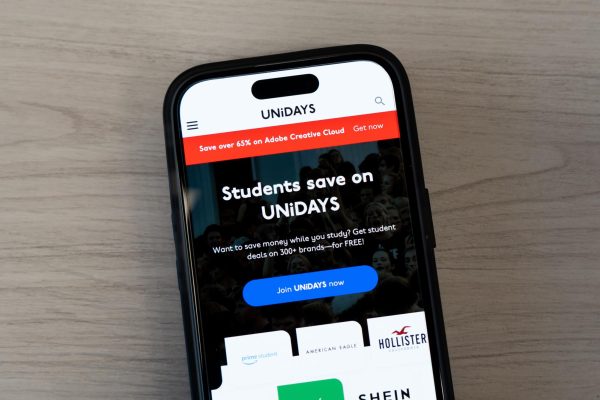Student Government looks at budget, funding
MONEY Many wonder how tuition fees are being spent to benefit campus.
Student brand managers for #besomebody Landon Bahl and Tyler Keehr present to Student Senate on Sept. 22. A bill was not drafted to fund #besomebody’s November visit to UND’s campus. Photo by Keisuke Yoshimura.
Budget frustrations are just as real for UND’s Student Government as they are for the federal government, according to UND senior Landon Bahl.
The #besomebody program — a motivation movement started in 2009 — is preparing to embark on a campus tour, which will visit 25 universities in 50 days. UND is one of these campuses.
Bahl and fellow student brand manager for #besomebody, UND freshman Tyler Keehr, approached Student Senate at its Sept. 22 meeting. At the meeting, Bahl and Keehr asked senate to write a bill allocating $10,000 to bring in motivational speaker Eric Thomas, who would keynote the event along with organization founder Kash Shaikh — as part of #besomebody’s Nov. 8 campus visit.
On Sept. 25, Bahl learned such a bill would not be written, as the idea lacked support from senators.
“#besomebody was shocked, you know ‘They didn’t approve funding for this event?’” Bahl said. “You know, that just goes back to Student Government. Every year we talk about bringing new, cool events to campus and this is one of those new, cool events that we’re doing all the groundwork for. And so, the question is: Why doesn’t Student Government approve this if its going to impact thousands?
“That’s just what we don’t get.”
Event Funding
Student Body President Nick Creamer said deciding what programs and initiatives receive funding isn’t always black and white.
For the 2014 fiscal year, Student Government’s total funds, split between several different accounts, amounts to $1,065,311.79. Of those funds, $673,983 come from student fees. According to Creamer, after various costs and expenses are covered, there is roughly $51,000 left to be allocated for various programming.
According to Student Body Treasurer Abi Nadeau, in addition to the majority of funds — which are allocated to the Student Organization Funding Agency and the University Programming Council — other high-level budget items are the College Readership Program, CAT Prowler and the Student Safe Ride program.
“I think most of these programs are, in my understanding, very import and significantly utilized,” Creamer said.
According to Creamer, these programs and others that have been carried over from previous administrations, amount to roughly $170,000 in the budget.
“As to whether something is worth funding or not, it’s really dependent on students and what they want,” Student Body Vice President Lexi Hanson said. “If students want it, if there’s a need, if there’s a desire, if it’s feasible, that’s what makes it worth funding.”
In the case of #besomebody, Creamer said senators were concerned about the event’s ability to garner a great enough attendance to make funding a second keynote speaker — Thomas — worthwhile.
“UND needs events such as the one we proposed, but, yet, senate year after year does not want to fund or create events such as the one we proposed or others,” Bahl said. “StuGov has money that is always left over year after year, which could be used to promote the students’ college and academic experience.”
All about impact
The only two senate-funded bills on the budget as of Tuesday were $30,000 for the Student Safe Ride Program — which allows students to get cab rides for a reduced rate — and $10,000 for the American Student Government Association’s annual National Summit conference in Washington, D.C., taking place this week.
Creamer said that, although $10,000 was budgeted for the ASGA conference, closer to $8,000 would actually be spent, as five executive team members are attending the conference — taking place this week — instead of the original seven for which were budgeted. According to Creamer, although the two events — ASGA and #besomebody — required the same amount of money to be budgeted, the outcomes of such funding would vary significantly.
“I think a motivational speaker would directly impact more student than the five us going to this conference will,” Creamer said. “However, I also think the ideal outcome would be the five of us would be able to come back from this conference with so many tools and resources that we would be able to impact far more students than this event.”
Both Creamer and Hanson said they are looking to base funding decisions off of student input and data gathered through student emails and outreach.
Students aren’t necessarily convinced.
“On a campus of 15,000 students, we lack a lot of involvement,” Bahl said. “That’s what we don’t get, is this is an event to get a lot of involvement.”
According to Nadeau, the channels for communication are open.
“As we go forward into this budget preparation cycle, the most important thing for students to know is that we all have a voice,” Nadeau said. “Reach out to your senators, the executives and the members involved in committees. Ask questions, give informed opinions and, with that, the budget will be able to reflect what we, as students, support.”
According to Student Government’s budget for the 2014 year, there is $380,073 held in its reserve account.
Student Government is working on rolling out an online budget within the next week.
Carrie Sandstrom is the editor-in-chief of The Dakota Student. She can be reached at carrie.sandstrom@my.und.edu



